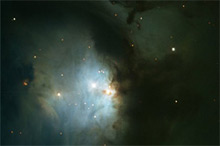Cosmic Frontier
Particle physics experiments at the Cosmic Frontier use the cosmos as a laboratory to investigate the fundamental laws of physics. Researchers use detectors to study particles from space as they approach and enter our atmosphere in forms such as cosmic rays, gamma rays and neutrinos emitted by the sun. These experiments allow researchers to test theories about how the universe was formed, what it is made of and what its future holds.
Experiments at the Cosmic Frontier may have the best chance of discovering the nature of dark matter and dark energy. Theorists have concluded that these two mysterious materials constitute 96 percent of the universe and may be responsible for its formation and accelerating expansion.
WIMPS and dark matter
No one has ever directly observed dark matter, but two clues led astronomers to suspect its existence. First, when researchers measured the masses of all the stars and planets that make up galaxies, they discovered that the gravity of those objects alone would not be great enough to hold them together. Something they could not see must have been contributing mass and therefore gravitational pull. Second, they observed in space the kind of distortions of light usually caused by large masses in areas that seemed empty.
The composition of dark matter is unknown, and its existence shows that the Standard Model of particle physics is incomplete. Several theories of particle physics, such as supersymmetry, predict that weakly interacting massive particles, WIMPs, exist with properties suitable for explaining dark matter.
The goal of several experiments at the Cosmic Frontier is to observe WIMPs directly.
Dark Energy
In the 20th century, astronomers first discovered that the universe was getting bigger. They found this by observing something similar to the Doppler effect in the light coming from distant galaxies. The Doppler effect is what causes a car horn to change in pitch from high to low as it approaches and passes. This happens because the sound waves are compressed as the car moves toward you, resulting in a higher pitch, and are stretched as it recedes, resulting in a lower pitch. As an object approaches you, the light waves coming from it compress. Astronomers call this blueshift. When light waves stretch as an object moves farther away, astronomers call it redshift.
By measuring the spectrum of an astronomical object, astronomers can tell how much the space between the object and observer has stretched as the light traveled through it. When astronomer Vesto Slipher measured light coming from other galaxies, he found that almost all were redshifted, or moving away. He found that those that seemed dimmer and farther away had even higher redshifts. The universe was expanding. This led astronomers to the idea of the big bang.
Astronomers assumed, however, that the force of gravity from all of the matter in the universe would slow the expansion. They were in for a surprise in 1998 when they discovered that the expansion was actually speeding up. Astronomers discovered this when they measured the brightness of the light coming from a certain type of supernova that always explodes with roughly the same energy. The dimmer the light from the supernova, the farther the distance it had traveled to Earth. They discovered that the supernovae were farther away than their redshift measurements predicted. The universe was expanding at an accelerating rate.
Some particle astrophysicists think this is happening because a force with a repulsive gravity is pushing the universe apart. They call this force dark energy. Many experiments at the cosmic frontier seek to study the nature of dark energy.



